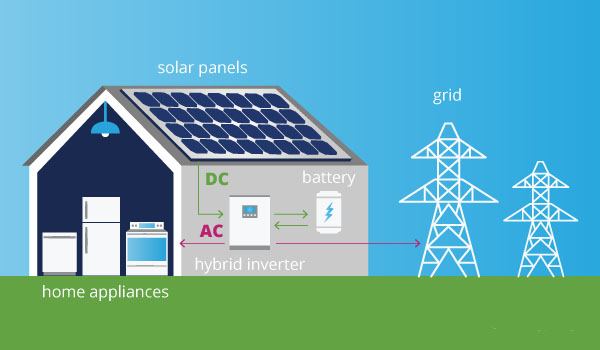Jun 28, 2020
All solar power systems work on the same principle. Solar panels first use the so-called photovoltaic effect to convert solar energy or sunlight into direct current. Then, the DC power can be stored in the battery, or converted into AC power by the solar inverter, which can be used to run household appliances. Depending on the type of system, excess solar energy can also be fed into the grid to provide credit and further reduce electricity costs.
Three main types of solar power systems
1. On-grid-also is known as grid-tie or grid-feed solar system
By far, grid-connected or grid-connected solar systems are the most common and widely used systems for homes and businesses. These systems do not require batteries, use ordinary solar inverters, and are connected to the public grid. Any excess solar energy you generate will be exported to the grid, and you will usually get a feed-in tariff (FiT) or a credit line for the energy you export.
Unlike hybrid power systems, grid-connected solar systems cannot operate or generate electricity during power outages due to safety reasons. Because power outages usually occur when the grid is damaged; if the solar inverter is still supplying power to the damaged grid, it will endanger the safety of the person repairing the grid fault. Most hybrid solar systems with batteries can be automatically isolated from the grid (called islands) and continue to provide some power during power outages.

2. Off-grid-also known as stand-alone power system (SAPS)
The off-grid system is not connected to the grid, so batteries are required. The off-grid solar system must be properly designed so that it generates enough electricity throughout the year and has sufficient battery capacity to meet the requirements of the family. Even in the depths of winter, the sun is generally much less.
The high cost of batteries and off-grid inverters means that off-grid systems are much more expensive than on-grid systems, so they are usually only needed in more remote areas far from the grid. However, battery costs are rapidly decreasing, so even in cities and towns, the market for off-grid solar cell systems is growing.
3. Hybrid-Solar plus battery storage and grid connection
Modern hybrid power systems combine solar energy and battery storage and now come in many different forms and configurations. Due to the reduction in battery storage costs, systems that are already connected to the grid can also start using battery storage. This means that the solar energy generated during the day can be stored and used at night. When the stored energy is exhausted, the grid serves as a backup, allowing consumers to have the best of the two worlds. The hybrid system can also use cheap off-peak power (usually after midnight to 6 am) to charge the battery.
The above information is provided by a hybrid grid system design company.
How Do Solar Panels Help The Environment?
Nov. 23, 2021
Follow Us
Navigation